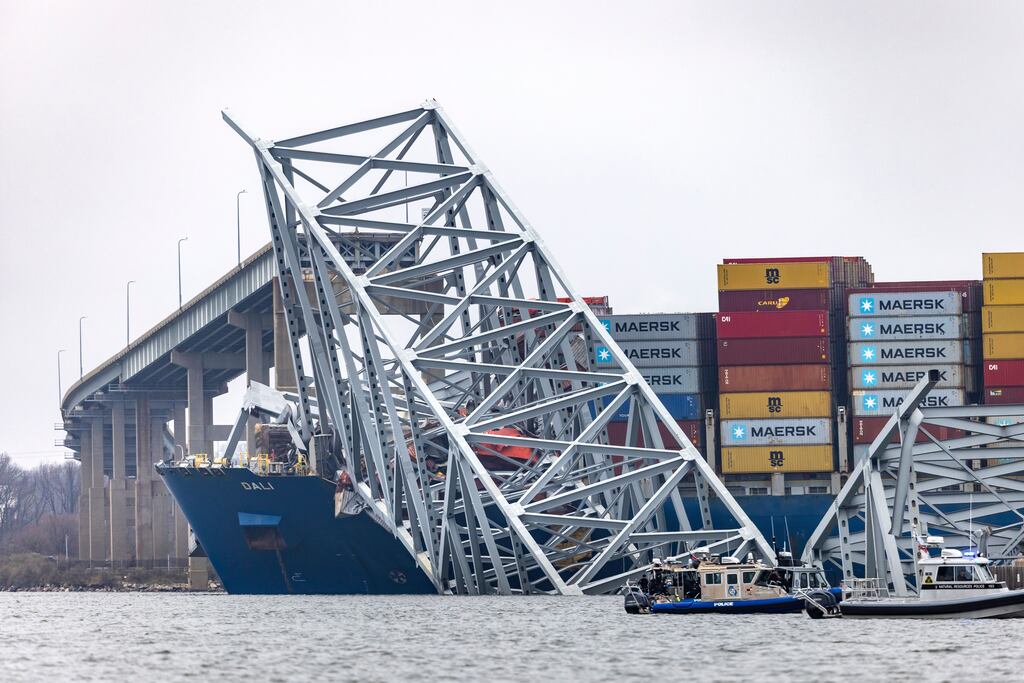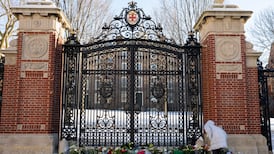Officials announced the recovery of two bodies on Wednesday from the water beneath the spot where the bridge in Baltimore collapsed after it was struck by a cargo ship on Tuesday. The two men had been been trapped in their vehicle after it fell from the bridge.
The men were identified as Alejandro Hernandez Fuentes (35), who was from Mexico and was living in Baltimore, and Dorlian Ronial Castillo Cabrera (26), who was from Guatemala and was living in Dundalk, Maryland.
The authorities said the men were found by divers in a red pickup truck underwater, and their loved ones were informed in person by officials on Wednesday afternoon, the public and media were told at an evening briefing.
Four other workers who had been on the bridge remain missing, presumed dead. The countries of origin of the victims are Guatemala, Honduras, El Salvador and Mexico, authorities said.
READ MORE
Earlier on Wednesday, US federal investigators on Wednesday examined the cargo ship that crashed into the Baltimore bridge while emergency teams searched for bodies and details emerged of the intense efforts to prevent the loss of life in the minutes before the steel span collapsed.
“Hold all traffic on the Key Bridge. There’s a ship approaching that just lost their steering,” someone said on police radio minutes before the 1.30am local time crash on Tuesday.
While voices were heard discussing the next steps, one broke through to say: “The whole bridge just fell down!” The audio was carried by Broadcastify, an open-source audio streaming service.
The recording offered a glimpse into how authorities scrambled before the crash destroying the Francis Scott Key Bridge caused six bridge repair workers on the night shift to plunge to their deaths in the frigid black waters of Baltimore Harbour.
The Singapore-flagged Dali, a container ship the length of three football fields, had reported a loss of power before the impact and dropped anchor to slow down the vessel, giving authorities barely enough time to halt traffic on the bridge and likely prevent greater loss of life.
The disaster closed the Port of Baltimore, one of the busiest on the US eastern seaboard, and created a traffic quagmire for Baltimore and the region, which is densely populated.
Investigators from the US National Transportation Safety Board (NTSB) recovered the data recorder after boarding the ship late on Tuesday, and returned to the vessel on Wednesday to interview the ship’s crew, other survivors and emergency responders, NTSB chair Jennifer Homendy said.
A highway team was due to examine the remains of the 2.6km-long bridge for answers as to how and why the container ship smashed into a support pillar.
Rescuers pulled two workers from the water alive on Tuesday, one of whom was hospitalised.
One worker from Mexico was rescued while two were missing, said Mexican president Andrés Manuel López Obrador.
The crew working on the bridge was repairing potholes on the road surface when the Dali ploughed into a pylon as it sought to leave the harbour for Sri Lanka.
A trestle section of the bridge almost immediately crumpled into the water, sending vehicles and the workers into the 15m-deep waters at the mouth of the Patapsco river.
Divers were looking for their remains amid a cold, steady rain. Maryland governor Wes Moore said the divers “are down there in darkness where they can literally see about a foot in front of them. They are trying to navigate mangled metal.”
The US coast guard’s priorities at present are to restore the waterway for shipping, and stabilise the vessel before extricating it, vice admiral Peter Gautier said at a White House news briefing.
The disaster had drawn attention to the vessel’s safety record, but Mr Gautier said: “This particular ship had a fairly good safety record.”
Of the ship’s 4,700 cargo containers, 56 hold hazardous materials, but there is no threat to the public, he said. Two containers went overboard during the crash but they did not contain hazardous materials.
The ship is carrying more than 1.5 million gallons of fuel oil, he added.
Data from the ship will provide investigators with a timeline of what happened, the NTSB’s Ms Homendy told reporters as she prepared to board the vessel. The NTSB scheduled a briefing for Wednesday evening.
The process will involve taking photos of the ship and the 47-year-old bridge and securing electronic logs. The agency will also examine whether contaminated fuel played a role in the ship’s loss of power, she said.
The Port of Baltimore handles more automobile freight than any other US port – more than 750,000 vehicles in 2022, according to port data, as well as container and bulk cargo ranging from sugar to coal.
The bridge collapse could cost insurers billions of dollars in claims, analysts said, with one putting the cost at as much as $4 billion (€3.69 billion), which would make the tragedy a record shipping insurance loss.
The loss of the bridge also snarled roadways across Baltimore, forcing drivers on to two other congested harbour crossings and complicating daily commutes and regional traffic detours for months or even years to come.
Up to now the bridge was carrying about 31,000 vehicles across the harbour daily and was serving as a main route between New York and Washington. It opened in 1977. – Reuters, Guardian














